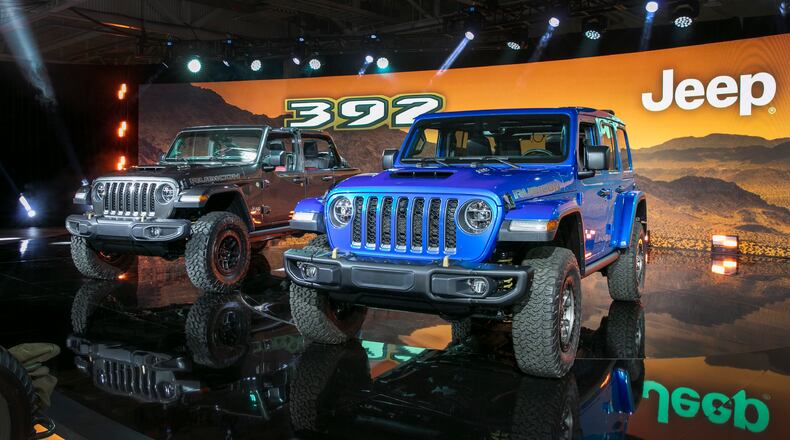That’s what you get when you drop a 6.4-liter V8 engine into a Wrangler, the first time a V8 has been in what is now known as the Wrangler in decades. The production version of this highly anticipated new Wrangler got its first showing in a virtual unveiling on YouTube.
You could ask why do this, but then you’re already missing the point. Jeepers do all kinds of things to their Wranglers.
“So many modified Jeep Wranglers are out there in the world that we were able to hide in plain sight during all of our testing adventures,” Standring said recently, noting that Wrangler 392s have been on the road since May 2019 in Arizona, Utah, California and in the mud of Michigan’s Drummond Island.
So why do it?
“That’s what our customers want. That’s what the Wrangler fans have been asking for over and over probably as much as they want bigger tires on these vehicles,” said Micky Bly, head of propulsion systems for Fiat Chrysler Automobiles.
The engine, which is mated to an 8-speed automatic, delivers 470 horsepower and 470 lbs.-ft. of torque. The 392 can manage a 0-60 mph time in 4.5 seconds, and in a twist for a Wrangler, FCA says it can make the quarter mile in 13 seconds. Yes, they tested it on the drag strip.
As noted, a V8 hasn’t been near a production Wrangler variant in decades. Fiat Chrysler happens to have a 1973 CJ5 with a 304 V8 in its museum fleet, a 7,000-mile original from Arizona, according to an email from spokesman Nick Cappa. That engine was introduced in the CJ5 in 1972 and wrapped up in the CJ7 in 1981, phased out because of lower V8 production.
It’s an interesting bit of history, but comparisons are tough. That version managed 125 HP and 220 lbs.-ft. of torque. Those were probably pretty big numbers then but would be considered fairly anemic now, Bly said.
Of course, if you’re buying a V8, you want the rumble of a V8, and so the 392 has that covered with its tuned exhaust.
The active dual exhaust system switches from standard drive-around-the-neighborhood-and-keep-the-peace” mode to a performance mode, “where everybody knows that you’re driving that V8 by the sound that you hear,” Bly said.
To handle the extra torque, the frame was modified. Other changes include thicker axle tubes for the heavy-duty Dana 44 front and rear axles. It’s also got a 2-inch factory lift and “specially-tuned high-performance Fox aluminum monotube shocks to maximize handling and comfort,” according to FCA.
For those times when the 392 is plowing through water, the Hydro-Guide air intake system can handle 15 gallons of water per minute over the hood, allowing it to traverse water up to 32.5 inches deep. A secondary air intake path means the SUV can still hit top speed if the functional hood scoop is covered in snow or mud, FCA said.
And so there’s no confusion with another trim level, the 392 has bronze-colored accents, tracing “Rubicon” on the hood, covering the front and rear tow hooks and outlining the Jeep and Trail Rated badges, the company said.
Sam Fiorani, vice president of global vehicle forecasting for AutoForecast Solutions, said the 392 is a powerful response to the new Jeep competitor on the block.
“With all of the hype behind the upcoming Ford Bronco, the Wrangler Rubicon 392 is the perfect way for Jeep to regain the spotlight. Combining the corporate monster 6.4L V8 with the extremely capable Wrangler creates a vehicle tailor-made for headlines and magazine covers,” he said. “Nobody buys a Wrangler to take to the drag strip, but the undeniable sound of the Hemi under the hood of the most traditional of Jeeps will have the faithful lining up for every one that will roll off of the assembly line.”
The 2021 Wrangler Rubicon 392 is expected in dealerships early next year. FCA did not release fuel mileage ratings or pricing. The vehicle is built at FCA’s Toledo Assembly Complex in Ohio, and the engine is produced at the Saltillo Engine Plant in Mexico.
About the Author
